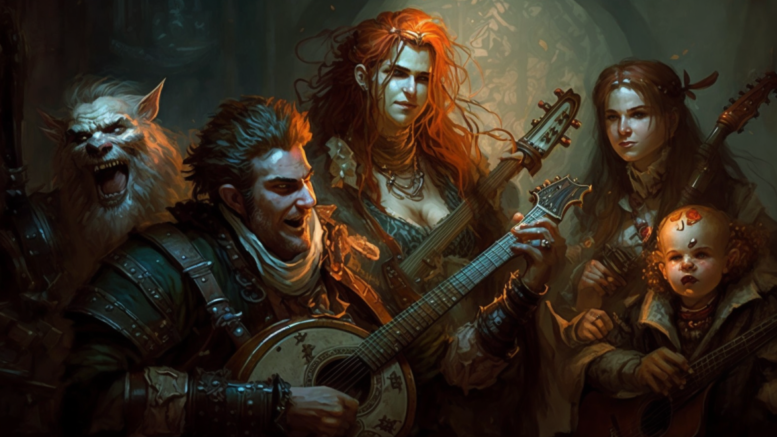Bards are one of the most versatile classes in both Dungeons & Dragons 5e and Pathfinder 2e, providing a wide range of abilities and play styles for players to choose from. However, like any class, there are both pros and cons to playing a bard, and the nuances of the class can differ between the two systems.
Pros of Playing a Bard
- Versatility: Bards are able to fill a variety of roles in a party, including healer, buffer, controller, and damage dealer. They have access to a wide range of spells, and their Bardic Inspiration ability allows them to boost the abilities of their allies.
- Social Skills: Bards are known for their charisma and their ability to talk their way out of almost any situation. They have access to a variety of skills that make them excellent at diplomacy, deception, and intimidation.
- Fun to Play: Bards are often considered one of the most fun classes to play, due to their ability to improvise and their focus on creativity and performance. They also have a lot of unique abilities, such as their ability to use musical instruments as weapons.
Cons of Playing a Bard
- Limited Combat Abilities: Bards are not known for their combat abilities, and they often struggle to keep up with other classes in terms of damage output. While they have a few offensive spells and abilities, their primary focus is on support and control.
- Limited Spellcasting: Bards have access to a smaller pool of spells than other spellcasting classes, such as wizards and sorcerers. They also have fewer spell slots, which means they have to be careful about how they use their spells.
- Requires Creativity: Playing a bard requires a certain amount of creativity, as they often rely on improvisation and performance to be effective. This can be challenging for some players who prefer more straightforward play styles.
Nuances of Playing a Bard in D&D 5e
In D&D 5e, bards are known for their versatility and their ability to fill multiple roles in a party. They have a lot of unique abilities, such as their Bardic Inspiration, which allows them to give allies a bonus to ability checks and attack rolls. Bards also have access to a variety of spells, including healing spells, damage spells, and utility spells.
One of the main differences between bards in D&D 5e and Pathfinder 2e is the way that spells are prepared. In D&D 5e, bards prepare spells from their entire spell list, but they can only cast a limited number of spells per day. This means that bards have to be strategic about which spells they prepare each day, and they have to think carefully about how they use their spells in combat.
Nuances of Playing a Bard in Pathfinder 2e
In Pathfinder 2e, bards are known for their focus on performance and their ability to use their performances to boost their allies. They have a variety of unique abilities, such as their composition spells, which allow them to cast spells while performing.
One of the main differences between bards in Pathfinder 2e and D&D 5e is the way that spells are prepared. In Pathfinder 2e, bards prepare spells from their entire spell list, but they can cast any spell they have prepared as many times as they have spell slots. This means that bards in Pathfinder 2e have a lot more flexibility when it comes to casting spells, and they can use their spells more freely in combat.
Examples of Playing a Bard in D&D 5e
In D&D 5e, a bard could be played as a support character who focuses on healing and buffing their allies. They could use spells like Cure Wounds and Healing Word to keep their allies alive, while using spells like Bless and Bane to boost or hinder their allies and enemies, respectively. They could also use their Bardic Inspiration ability to give their allies extra bonuses to their attacks and abilities.
Alternatively, a bard in D&D 5e could be played as a controller, using spells like Hypnotic Pattern and Fear to control the battlefield and limit the actions of their enemies. They could also use spells like Faerie Fire and Shatter to deal damage to multiple enemies at once.
Examples of Playing a Bard in Pathfinder 2e
In Pathfinder 2e, a bard could be played as a performer who uses their abilities to entertain and inspire their allies. They could use their composition spells to cast spells while performing, and they could use their performance to boost the abilities of their allies.
Alternatively, a bard in Pathfinder 2e could be played as a damage dealer, using their spells and abilities to deal damage to their enemies. They could use spells like Dissonant Whispers and Vicious Mockery to deal psychic damage, and they could use their weapon skills and abilities to deal physical damage.
Conclusion
In conclusion, playing a bard in either D&D 5e or Pathfinder 2e can be a lot of fun, but it does come with its own set of pros and cons. Bards are versatile, creative, and great at social skills, but they also have limited combat abilities and require a certain amount of creativity to play effectively. However, the nuances of playing a bard can differ between the two systems, and players should be aware of these differences when choosing to play a bard in either system. Regardless of which system you choose, playing a bard can be a rewarding experience, and can offer a unique and enjoyable play style for those who enjoy creativity and improvisation.

Be the first to comment on "Finding the Right Tune: Nuances of Playing a Bard in D&D 5e and Pathfinder 2e"